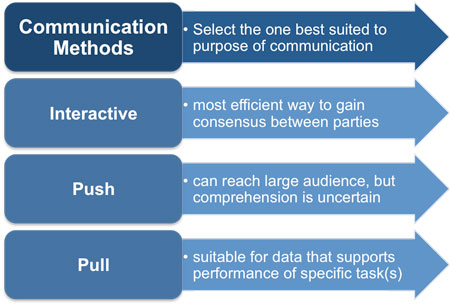Effective Communication in Project Management
| Line 16: | Line 16: | ||
This type of communication is used from sender to receiver. It is preferable when the sender sends information and do not want an immediate response from receiver or when the information do not need immediate response because is not pressing or as important. | This type of communication is used from sender to receiver. It is preferable when the sender sends information and do not want an immediate response from receiver or when the information do not need immediate response because is not pressing or as important. | ||
Examples of Push Communication are : emails, letter, reports or faxes. It is not a face-to-face communication but always an information through a written medium. | Examples of Push Communication are : emails, letter, reports or faxes. It is not a face-to-face communication but always an information through a written medium. | ||
| + | |||
| + | Take, for example, you have a technical issue that demands immediate attention, and you alert the Tech department of your company to fix it. You send the Tech guy a mail. He isn't available for the day and is therefore not able to receive and attend to your mail. You only know that the mail you wrote has been successfully sent. You do not know if he has received it or not. You will only know that he has when he comes and fixes our problem that will be the next day. [2] | ||
=== Pull Communication === | === Pull Communication === | ||
| + | |||
| + | This type of communication is used from sender to a large audience. All members that want to have information can access to in through a common way. Example of Pull Communication are post on websites, Podcasts, blogs, exc. The reicever has to recover this information. | ||
| + | |||
| + | A sample-case scenario would be when you have enrolled for a project management course and need access to more inputs on your course, and you begin to search for relevant information from the Articles/Ebooks that is available on the training provider’s site itself.[2] | ||
| + | |||
== Methods of Communication == | == Methods of Communication == | ||
=== Verbal Communication === | === Verbal Communication === | ||
| Line 23: | Line 30: | ||
=== Visual Communication === | === Visual Communication === | ||
| + | ==Limitations == | ||
== Conclusion == | == Conclusion == | ||
==References == | ==References == | ||
[1]http://www.free-management-ebooks.com/faqpm/team-07.htm | [1]http://www.free-management-ebooks.com/faqpm/team-07.htm | ||
| + | |||
| + | [2]http://www.simplilearn.com/interactive-vs-push-vs-pull-communication-in-project-management-article | ||
Revision as of 17:14, 23 September 2015
Communication is one of the most important part of project management. Working on a project there must be a good communication between who is planning the work and who is working on it. A successful project manager must be a great communicator. Doing the same things with the same people in the same place is never possible because the projects are always different, and for these reasons every project needs the best way to communicate between manager and workers.
Contents |
Communication in Project Management
Hence, employing effective communication methods are necessary to ensure project success
Effective Communication
The project manager decides, based on communication requirements, what, how, and when communication methods are to be used in the project. This process requires discussion and dialogue with the project team to determine the most appropriate way to update and communicate project information, and to respond to requests from various stakeholders for that information. [1]
Interactive Communication
An interactive communication is required when the communication is likely to be misinterpreted. Every stakeholder can respond to each other in real time
Push Communication
This type of communication is used from sender to receiver. It is preferable when the sender sends information and do not want an immediate response from receiver or when the information do not need immediate response because is not pressing or as important. Examples of Push Communication are : emails, letter, reports or faxes. It is not a face-to-face communication but always an information through a written medium.
Take, for example, you have a technical issue that demands immediate attention, and you alert the Tech department of your company to fix it. You send the Tech guy a mail. He isn't available for the day and is therefore not able to receive and attend to your mail. You only know that the mail you wrote has been successfully sent. You do not know if he has received it or not. You will only know that he has when he comes and fixes our problem that will be the next day. [2]
Pull Communication
This type of communication is used from sender to a large audience. All members that want to have information can access to in through a common way. Example of Pull Communication are post on websites, Podcasts, blogs, exc. The reicever has to recover this information.
A sample-case scenario would be when you have enrolled for a project management course and need access to more inputs on your course, and you begin to search for relevant information from the Articles/Ebooks that is available on the training provider’s site itself.[2]
Methods of Communication
Verbal Communication
Nonverbal Communication
Visual Communication
Limitations
Conclusion
References
[1]http://www.free-management-ebooks.com/faqpm/team-07.htm
[2]http://www.simplilearn.com/interactive-vs-push-vs-pull-communication-in-project-management-article
